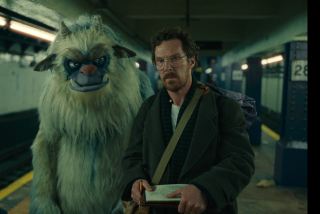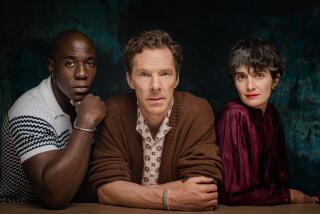Review: ‘Ernest & Celestine’ a magical bonbon with painterly touch
- Share via
“Ernest & Celestine,” the charming French-Belgium animated film and Oscar contender, is about a bear and a mouse whose artistic tendencies are forever getting them into trouble. Marked as outsiders by their respective societies, an unlikely friendship is forged, an ill-tempered uproar unleashed, and a delightful movie is the result.
Based on the lovely children’s books by Gabrielle Vincent, with a screenplay by noted novelist Daniel Pennac (“Cabot-Caboche”), this lively and larcenous tale is softened by its watercolor pastiche and minimalist animation. A magically understated mash-up, “Ernest & Celestine” has a comforting storybook effect and proves a refreshing departure in an age of high-tech, hyperkinetic animation set to soaring pop ballads, as entertaining as they can be.
The film is directed by three filmmakers, Belgium veterans Vincent Patar and Stephane Aubier, probably best known here for their 2009 animated comic adventure, “The Town Called Panic,” and Benjamin Renner, a novice discovered at the respected French animation graduate school, La Poudriere. I’m sure we’ll be seeing much more from Renner.
OSCARS 2014: Full coverage | Top nominees
Together with Pennac’s amusingly irreverent storytelling style, the filmmakers have created a world of clashing mice and bears that is true to the original artistic imprint of Vincent and yet takes on a new life of its own. Originally voiced in French, it’s been recast for the U.S. release with Forest Whitaker filling Ernest’s big bumbling bear shoes and Mackenzie Foy (“Twilight’s” Renesmee) as the tiny and anything but timid Celestine.
They have not yet been introduced when the film opens. Celestine is tucked into one bed in a row of beds inside an orphan’s dorm. The Grey One (Lauren Bacall), a loose-toothed crone, scares the living daylights out of her charges with bedtime tales of the horrible terrors of bears.
The Grey One’s loose tooth may seem insignificant until it becomes clear how much the underground society of mice dentists depends on teeth — keeping them, replacing them, sharpening them and constructing entire mice cities with their help. Indeed, teeth are the bedrock of Celestine’s existence. A pity, she likes to draw; dentistry simply doesn’t interest her.
In the snow-covered countryside far, far away, inside a snow-covered house, Ernest is sleeping the winter away, until a certain ache in his stomach gets him up and searching for something, anything, to eat. Though the house is already a mess, it will be a greater one before he sets out for the city in search of a morsel or two. He’s a musician, but his street busking attracts no attention from anyone but the cops.
VIDEO: Animators roundtable: Full interview
The painterly style, though it moves, can feel as if the images are being pulled right off a storybook page. It somehow works to give a certain shading and shape to our two main characters in the process. Ernest, all soft browns and big belly, is hard to be intimidated by and Celestine, wrapped in good intentions and a cape that evokes Red Riding Hood, is more adorable than any rodent should be.
Once we fully understand Ernest and Celestine’s outsider standing, a series of unfortunate events puts them face to face on a city street, Ernest on the verge of popping Celestine into his mouth, the mouse in the midst of delivering him a lecture on the terribleness of crunching her bones. A friendship is born, and perhaps a film franchise is too.
Like many children’s fables, the world of Celestine and Ernest can be understood on many levels. Pennac’s storytelling and the enchanting, enhancing animation makes it easy and enjoyable to do so. Bears live above ground, the mice underneath. Though the little furries make forays to the world above, primarily to snatch loose bear teeth for their foundries, the bears never venture below until still more unfortunate events land Ernest in their clutches.
Any friendship between the species is frowned on, forbidden, unthinkable. That drives the conflicts in the film as well as making the metaphoric possibilities nearly endless.
The filmmakers, though, are as intent on having fun as on sending serious messages, and it is an absolute delight to watch the pals get in and out of scrapes as the bonds of their friendship deepen to make them a modern family. Though their size differential and their disparate talents are played for laughs, one captivating aspect of the film is the way the images emerge — at times from nothing more than a drop of color, other times entire props are painted out of sight.
From its inventive visuals to its unruly heroes, “Ernest & Celestine” is an equal pleasure for children and adults. A modern-day period piece, a fabulous fable, a most fortunate use of animation artistry, I can’t help but believe that Vincent, who refused to allow her books to be translated to TV or film during her lifetime, would be well pleased.
[Update 11:22 a.m. PST, Feb. 28: No MPAA rating for ‘Ernest & Celestine’ was listed in a previous version of this post. The movie is rated PG.]
-------------------------------------
‘Ernest & Celestine’
MPAA Rating: PG for some scary moments.
Running time: 1 hour, 20 minutes
Playing: At Landmark Theatres, West Los Angeles
More to Read
Only good movies
Get the Indie Focus newsletter, Mark Olsen's weekly guide to the world of cinema.
You may occasionally receive promotional content from the Los Angeles Times.











